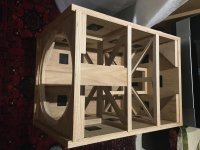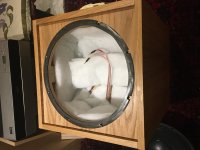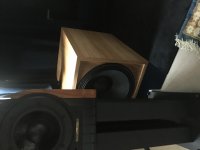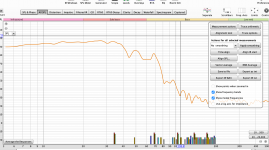Hearing damage is a real issue and many classical musicians have to wear ear plugs in recording sessions or at concerts...
Which Instruments Put Your Hearing Most at Risk? | Hearing & Balance Center | Blog
We live in a remote village and our lounge is very heavily damped so we have around 31dB of ambient noise level, very low. When listening to music or watching movies on my home system, the dynamic range covered is around 75dB to 80dB ie from 30dB to 110dB peaks at 1 meter. The sofa is 4 to 5 meters away from the front of the speakers so peaks of around 95dB to 100dB with lows just whispering above ambient... Jump scares are soooo scary!
Which Instruments Put Your Hearing Most at Risk? | Hearing & Balance Center | Blog
We live in a remote village and our lounge is very heavily damped so we have around 31dB of ambient noise level, very low. When listening to music or watching movies on my home system, the dynamic range covered is around 75dB to 80dB ie from 30dB to 110dB peaks at 1 meter. The sofa is 4 to 5 meters away from the front of the speakers so peaks of around 95dB to 100dB with lows just whispering above ambient... Jump scares are soooo scary!
Mic placement distance... Anything from 10 cm to a couple of meters usually.
That level at that distance I can believe!
Its insane how much difference distance makes to SPL when mic'ing up most sources. Unless you have the luxury of Abbey Road space its always a compromise in some way or another.
DPA have recorded 130dB from a close mic'd grand piano...!!
Piano Microphones - How to mic and record a grand piano
DPA have recorded 130dB from a close mic'd grand piano...!!
Piano Microphones - How to mic and record a grand piano
PS- Unrelated but interesting... Distance SPL effects work both ways and its a great reason to use slim on wall line arrays ( full floor to ceiling height) at home as the SPL drop of with each doubling of distance is half that of any point source loudspeaker.... This makes a huge difference at 4 or 5 meters as the drivers are only working a fraction as hard in line arrays... Plus the huge Sd (driver surface area) benefit from line arrays.
I'm a bit of a pedant about meaningless dB levels thrown around without distance - it's like a pressure of 25 Newtons or a density of 50kg... 😉
PS- Unrelated but interesting... Distance SPL effects work both ways and its a great reason to use slim on wall line arrays ( full floor to ceiling height) at home as the SPL drop of with each doubling of distance is half that of any point source loudspeaker.... This makes a huge difference at 4 or 5 meters as the drivers are only working a fraction as hard in line arrays... Plus the huge Sd (driver surface area) benefit from line arrays.
I feel that arrays (PA-style) are ok if the listener is well back from the Critical Distance, but I don't get on with the dramatic difference in phase/arrival times of arrays in the Near Field caused by the hugely varying path lengths from the ear to each driver.
I'm not sure I agree that 3dB is a 'huge' difference in reduced theoretical propagation loss in a domestic environment, but the reduced (multiple) driver excursion is definitely a winner!
Last edited:
Its not a total of 3dB difference,,, its multiples of 3dB
The difference between line array SPL and point source SPL is a wee bit more complex... Point sources drop SPL by 6dB per doubling of distance.
Line Sources SPL drop by 3dB per doubling of distance.
Take a stage with a typical horn loaded compression driver based PA stack, a point source producing a 130 dB at 1 meter Vs a Line Array loudspeaker next to it, also producing 130dB at 1 meter.
At 2 meters - Point source hits 124 dB. Line array hits 127dB.
At 4 meters - Point source hits 118 dB. Line array hits 124dB.
At 8 meters - Point source hits 112 dB. Line array hits 121dB.
At 16 meters - Point source hits 106 dB. Line array hits 118dB.
At 32 meters - Point source hits 100 dB. Line array hits 115dB.
At 64 meters - Point source hits 94 dB. Line array hits 112dB.
A difference of 18dB when you are at the back of the venue.... Thats a huge difference. Also it means the front rows are getting hearing damage and the back rows are saying the volume is too low... Bad PR and unhappy campers!
Its actually even more significant in home audio/home cinema.
In domestic audio a typical 4 meter listening distance the line array has a 6dB advantage, not huge but still very desirable... Many DIY guys would kill for a "free" worth of increased sensitivity.
Plus the reduced cone travel that comes with a 6dB reduction in amplifier volume.
I used on wall line line arrays with 16 full range drivers (well, 80Hz to around 15KHz) each driver had a Sd of 70 square cm, so total of 1,120 square cm Sd... Compare that to a typical 8 inch or 10 inch bass, plus 4 or 5 inch mid plus 1.5 inch dome tweeter... Around 280 to 380 square cm.
So the Line array cones are moving +/- 1mm Vs +/- 6mm for the point source for both systems to produce identical SPL at a 4 meter listening distance.... Thats Night Vs Day difference in most forms of distortion.
The difference between line array SPL and point source SPL is a wee bit more complex... Point sources drop SPL by 6dB per doubling of distance.
Line Sources SPL drop by 3dB per doubling of distance.
Take a stage with a typical horn loaded compression driver based PA stack, a point source producing a 130 dB at 1 meter Vs a Line Array loudspeaker next to it, also producing 130dB at 1 meter.
At 2 meters - Point source hits 124 dB. Line array hits 127dB.
At 4 meters - Point source hits 118 dB. Line array hits 124dB.
At 8 meters - Point source hits 112 dB. Line array hits 121dB.
At 16 meters - Point source hits 106 dB. Line array hits 118dB.
At 32 meters - Point source hits 100 dB. Line array hits 115dB.
At 64 meters - Point source hits 94 dB. Line array hits 112dB.
A difference of 18dB when you are at the back of the venue.... Thats a huge difference. Also it means the front rows are getting hearing damage and the back rows are saying the volume is too low... Bad PR and unhappy campers!
Its actually even more significant in home audio/home cinema.
In domestic audio a typical 4 meter listening distance the line array has a 6dB advantage, not huge but still very desirable... Many DIY guys would kill for a "free" worth of increased sensitivity.
Plus the reduced cone travel that comes with a 6dB reduction in amplifier volume.
I used on wall line line arrays with 16 full range drivers (well, 80Hz to around 15KHz) each driver had a Sd of 70 square cm, so total of 1,120 square cm Sd... Compare that to a typical 8 inch or 10 inch bass, plus 4 or 5 inch mid plus 1.5 inch dome tweeter... Around 280 to 380 square cm.
So the Line array cones are moving +/- 1mm Vs +/- 6mm for the point source for both systems to produce identical SPL at a 4 meter listening distance.... Thats Night Vs Day difference in most forms of distortion.
My personal listening preferences include the ability to hit low distortion life like dynamics (real vocals and piano hit 115dB peaks in music rooms or typical studio live rooms), accurate tone and a well balanced frequency response which can be Eq'd to match room acoustics as I have found this a key factor in high performance home audio.
Hope this helps.
Lol, I think I’ve found my soulmate!
Hearing the first pair of Living voice Tone Scouts in the early 90's made me appreciate that clean dynamics and capabilities at high SPL with reduced distortion and compression is key for real life dynamics
volume.
I used on wall line line arrays with 16 full range drivers (well, 80Hz to around 15KHz) [/I][/B]
The lobing of the upper mid/HF response using those 120mm-ish drivers can only be imagined...😉
For sure. its hard to beat a really well designed front loaded horn system if its fed with a clean signal and controlled by DSP.
If I had the room and the budget thats what I would love to build... One day maybe!
If I had the room and the budget thats what I would love to build... One day maybe!
Ironic
This is actually 100% correct, and by that I mean the upper lobbing (not lobing!) is actually NOT REAL in real rooms at real listening distances with full length floor to ceiling line arrays!!
The kind of lobbing you are referring to is the theoretical type bandied about forums and audio websites by two types of people:
(1) Those who lack the knowledge, room, measuring equipment and software
to carry out accurate tests which would stand up to peer reviewing by qualified professionals.
(2) Those who have all of the above BUT are vested interests... ie they dont sell domestic line arrays... Pretty much all of the commercial domestic home entertainment world!
In the 80's and 90's well meaning "guru's" read and repeated in their "Cookbooks" and loudspeaker "bibles" the theories of "the loudspeaker greats" of the 20's and 30's... You know who I am talking about!
Only in the last 5 to 10 years as science has unravelled the truly staggering complexity of the Human Auditory System (HAS) and super computer power became cheap enough that the lower priority research subjects like IN ROOM loudspeaker behaviour got some serious attention by NON VESTED INTERESTS ie not Harman!!
The attached gives you an over view but there is still much to discover.
The two main points I try to explain to encourage people to research this fascinating subject are:
(1) The HAS is not designed to listen to sounds in domestic rooms at typical 3 to 5 meter listening positions which are dominated by reflections not direct sound.
(2) Our HAS evolved when we were forest dwelling chimpanzees and is designed to prioritise where sounds are located, not what they are.
Finally (!) imagine sitting on a sofa 4 meters away from a pair of floor to ceiling on wall line arrays using 4.5 inch (3 to 5 inch works). Now, try imagine the 10,000's of different reflections and path lengths from your ear to each driver (32 drivers in my case) and you can begin to see that there is such a huge excess of path lengths and routes bouncing of every part of every wall and the floors and ceiling. The number of lobbing cancellations is limited to the direct sound ie straight line from your ear to ONE DRIVER at one fixed listening position... Move your head in any direction and that one direct path cancellation no longer exists. The reflections "fill in the gaps" resulting in the cancellations being vastly out numbered by the non cancellations. Hope I am explaining this ok!
Anyway, check out the dozens of great examples on this forum of great full length line arrays with ZERO real lobbing issues...
The lobing of the upper mid/HF response using those 120mm-ish drivers can only be imagined...😉
This is actually 100% correct, and by that I mean the upper lobbing (not lobing!) is actually NOT REAL in real rooms at real listening distances with full length floor to ceiling line arrays!!
The kind of lobbing you are referring to is the theoretical type bandied about forums and audio websites by two types of people:
(1) Those who lack the knowledge, room, measuring equipment and software
to carry out accurate tests which would stand up to peer reviewing by qualified professionals.
(2) Those who have all of the above BUT are vested interests... ie they dont sell domestic line arrays... Pretty much all of the commercial domestic home entertainment world!
In the 80's and 90's well meaning "guru's" read and repeated in their "Cookbooks" and loudspeaker "bibles" the theories of "the loudspeaker greats" of the 20's and 30's... You know who I am talking about!
Only in the last 5 to 10 years as science has unravelled the truly staggering complexity of the Human Auditory System (HAS) and super computer power became cheap enough that the lower priority research subjects like IN ROOM loudspeaker behaviour got some serious attention by NON VESTED INTERESTS ie not Harman!!
The attached gives you an over view but there is still much to discover.
The two main points I try to explain to encourage people to research this fascinating subject are:
(1) The HAS is not designed to listen to sounds in domestic rooms at typical 3 to 5 meter listening positions which are dominated by reflections not direct sound.
(2) Our HAS evolved when we were forest dwelling chimpanzees and is designed to prioritise where sounds are located, not what they are.
Finally (!) imagine sitting on a sofa 4 meters away from a pair of floor to ceiling on wall line arrays using 4.5 inch (3 to 5 inch works). Now, try imagine the 10,000's of different reflections and path lengths from your ear to each driver (32 drivers in my case) and you can begin to see that there is such a huge excess of path lengths and routes bouncing of every part of every wall and the floors and ceiling. The number of lobbing cancellations is limited to the direct sound ie straight line from your ear to ONE DRIVER at one fixed listening position... Move your head in any direction and that one direct path cancellation no longer exists. The reflections "fill in the gaps" resulting in the cancellations being vastly out numbered by the non cancellations. Hope I am explaining this ok!
Anyway, check out the dozens of great examples on this forum of great full length line arrays with ZERO real lobbing issues...
Attachments
Last edited:
One of the most enjoyable experiences I had with my horns was listening to Theloneous Monk at silly volumes sat 20’ away from a single Horn. It made me think why do you need two speakers ��, it had such listen to the radio ease and simply filled the room with music. Not sure why I’m adding a 4th sub to my cinema room !
Good old mono is the one!
When you come down to it all natural sounds are mono, everything from a snapping twig, to a piano note, vocal chord vibration or violin... Stereo is an "unnatural" man made attempt to recreate natural mono sounds.
When you come down to it all natural sounds are mono, everything from a snapping twig, to a piano note, vocal chord vibration or violin... Stereo is an "unnatural" man made attempt to recreate natural mono sounds.
Good old mono is the one!
When you come down to it all natural sounds are mono, everything from a snapping twig, to a piano note, vocal chord vibration or violin... Stereo is an "unnatural" man made attempt to recreate natural mono sounds.
I assume the reasoning for stereo was having a sound source for each ear. Makes you wonder... if we evolved with three ears would they have recomended three speakers?
Off topic: what drive units do you use for your line arrays?
I bought a stack (about 50 all in) of the last Rapid Energy Decay RED drivers from Overkill Audio before he stopped selling them.
Hello, everything quite impressing, looking to IWC Doppels design. I like the use of dsp to make the frequency response work. In my experience trying out EQs showed me how sensitive the ear is to variations in loudness at different frequencies. Take 2 db too much treble and it will make you unhappy with your speakers in the long run. (For example).
I was a little bit amused about how some think that 18 inch drivers might not be able to reproduce low frequencies loud enough.
Big drivers like 18 inch should have less problems only due to driver surface than smaller drivers.
I was quite impressed with the Tymphany 15 inch bass. What a well designed monster!
I was a little bit amused about how some think that 18 inch drivers might not be able to reproduce low frequencies loud enough.
Big drivers like 18 inch should have less problems only due to driver surface than smaller drivers.
I was quite impressed with the Tymphany 15 inch bass. What a well designed monster!
Last edited:
Early days, I set by ear and one expected EQ last night (room mode) and it was stunning, the film was superb effortless deep tight bass and a greater sense of scale, no boom, no drone and very impactful
This morning I EQ'd and set level to match in with the other 3 subs and time aligned, Wow this fellow goes low, measuring from 5Hz, I'll run to 40 Hz perhaps a little less. This is EQ's with just two PEQ filters at 30 and 34 Hz and rolling off from 40 Hz, I'll probably roll of quicker
This morning I EQ'd and set level to match in with the other 3 subs and time aligned, Wow this fellow goes low, measuring from 5Hz, I'll run to 40 Hz perhaps a little less. This is EQ's with just two PEQ filters at 30 and 34 Hz and rolling off from 40 Hz, I'll probably roll of quicker
Attachments
- Home
- Loudspeakers
- Subwoofers
- 18" sealed sub of modest dimensions



